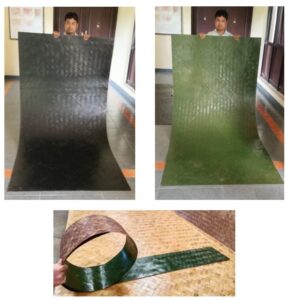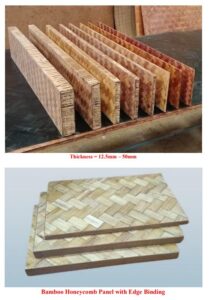India has a long history of bamboo cultivation — from traditional rural use to modern-day applications in construction, furniture, paper, and handicrafts. In recent years, bamboo has emerged as a profitable and eco-friendly crop, well-suited for integration into agroforestry systems.
Bamboo isn’t just a crop; it’s a natural resource powerhouse. It grows rapidly, improves soil quality, helps control erosion, and supports multiple crops in its understory. With the government promoting bamboo cultivation under initiatives like the National Bamboo Mission, farmers across India have an excellent opportunity to diversify their income while improving ecological health.
Why Bamboo Agroforestry?
Fast growth & early returns: Most bamboo species are ready for harvest within 3–5 years.
Year-round income: Bamboo can be intercropped with high-value short-duration crops.
Eco-benefits: Bamboo sequesters carbon, controls soil erosion, and improves moisture retention.
1. Intercropping Bamboo with Food Crops
During the first 2–3 years, bamboo allows enough sunlight for short-duration crops. Farmers can grow:
Maize, soybean, cowpea, or upland rice for food and fodder.
Root and tuber crops like ginger, turmeric, colocasia, and sweet potato.
Vegetables such as tomato, chili, okra, spinach, pumpkin, and beans.
Tip: Use improved high-yielding varieties suited to your agro-climatic zone for better returns.
2. Fruit and Plantation Crops for Long-Term Income
Many fruit trees thrive alongside bamboo, especially when planted in alley or border cropping systems:
Citrus (lemon, lime, mandarin), papaya, banana, guava.
Black pepper can be trained to climb bamboo poles — a smart vertical farming technique.
Coffee and cacao in humid zones such as the Western Ghats.
Tip: Spacing bamboo rows at 4–6 meters ensures adequate sunlight and root space.
3. Spices, Medicinal, and Aromatic Plants
India has a strong market for medicinal and aromatic plants, making them ideal companions for bamboo:
Spices: Ginger, turmeric, cardamom.
Aromatic plants: Vetiver, lemongrass, citronella (for essential oils).
Medicinal plants: Tulsi (holy basil), ashwagandha, aloe vera.
Tip: Bamboo’s semi-shade microclimate supports the growth of shade-loving herbs.
4. Soil-Improving Legumes
Incorporating legumes enhances soil fertility and reduces fertilizer costs:
Sesbania, pigeon pea, sunhemp, and Crotalaria are excellent green manure crops.
Legumes fix nitrogen and improve soil structure, boosting bamboo growth.
Tip: A rotation of legumes every season can keep your soil healthy and productive.
5. Livelihood Diversification: Beyond Crops
Bamboo agroforestry isn’t limited to farming. It supports integrated livelihoods:
Beekeeping: Bamboo flowers and intercrops attract pollinators and produce honey.
Mushroom cultivation: Shade and bamboo litter create the perfect microclimate for Oyster mushroom and others.
Fodder production: Napier grass and other fodder species can be grown in alleys for livestock.
Tip: Integrated systems increase resilience and income stability.
Regional Recommendations Across India
North East & Eastern India: Turmeric + Ginger + Black pepper with Bambusa balcooa or Dendrocalamus hamiltonii.
Central & Eastern Plateau: Maize or soybean in early years, transitioning to citrus and lemongrass.
Southern India: Banana, black pepper, and pineapple intercropping with Bambusa bambos.
North India (Plains): Mustard, pulses, and vegetables with Dendrocalamus strictus.
Detailed Regional Guide:
North East India (e.g., Assam, Arunachal Pradesh, Meghalaya, Manipur)
Favor clumping bamboo species like Bambusa balcooa and Dendrocalamus hamiltonii — they thrive in high rainfall zones.
Ideal intercrops: ginger, turmeric, black pepper, pineapple, colocasia.
Ensure drainage on sloped lands to prevent waterlogging and bamboo rot.
Eastern India (e.g., West Bengal, Odisha, Jharkhand, Bihar)
Moderate to high rainfall supports mixed cropping, but avoid low-lying flood zones.
Start with maize or pulses in early years, transition to citrus or lemongrass later.
Manage bamboo spacing carefully to maintain light for intercrops.
Central India (e.g., Madhya Pradesh, Chhattisgarh)
Choose drought-tolerant bamboo like Dendrocalamus strictus.
Good intercrops: pigeon pea, groundnut, sesame, mustard, cowpea.
Use mulching and micro-irrigation to conserve moisture during dry months.
Northern Plains (e.g., Uttar Pradesh, Haryana, Punjab, Bihar plains)
Species like Dendrocalamus strictus and Bambusa bambos work well in irrigated systems.
Ideal intercrops: wheat, mustard, vegetables (okra, tomato), pulses.
Watch for frost in winter; young bamboo may need protection.
Southern India (e.g., Kerala, Tamil Nadu, Karnataka, Andhra Pradesh, Telangana)
Choose species suited to humid or semi-arid zones — e.g., Bambusa bambos, Bambusa vulgaris.
Intercrops: banana, black pepper, turmeric, pineapple, arecanut (border planting).
Irrigation and mulching are critical during dry summer months.
Himalayan Region & Foothills (e.g., Uttarakhand, Himachal Pradesh, Jammu and Kashmir)
Choose cold-tolerant bamboo species like Drepanostachyum falcatum or Bambusa nutans.
Intercrops: temperate vegetables, pulses, medicinal herbs.
Protect young plantations from frost and snow in early years.
Western India (e.g., Gujarat, Rajasthan, Maharashtra (dry zones))
Use drought-hardy bamboo species like Dendrocalamus strictus and Bambusa tulda.
Intercrops: castor, sesame, pulses, medicinal plants like aloe vera and ashwagandha.
Drip irrigation and mulching are essential for establishment.
Coastal Regions (e.g., Goa, coastal Maharashtra, Andaman and Nicobar Islands)
Select salt-tolerant bamboo and ensure proper drainage during monsoon.
Good intercrops: coconut, banana, black pepper, lemongrass.
Windbreak and storm protection structures may be needed.
Agroforestry Design Tips
Maintain 4–6 m spacing between bamboo rows for efficient intercropping.
Use drip irrigation for water efficiency.
Incorporate leguminous crops to improve soil fertility.
Mulch bamboo basins with bamboo leaves to conserve moisture.
After 3–4 years, switch to shade-tolerant crops as canopy develops.
Practice regular harvesting and thinning: harvesting bamboo shoots and poles regularly to manage shade.
Toward a Greener and Profitable Future
Bamboo agroforestry is a win-win for farmers and the environment. It generates steady income, improves soil health, supports biodiversity, and helps fight climate change. With proper planning and crop selection, bamboo plantations can become thriving, multi-layered farming systems across India.
“Bamboo is not just a plant; it’s a livelihood opportunity waiting to grow.”





